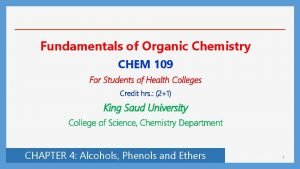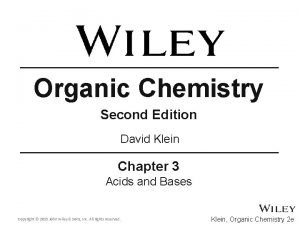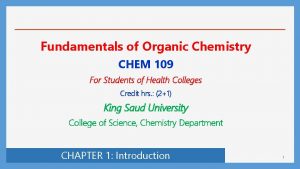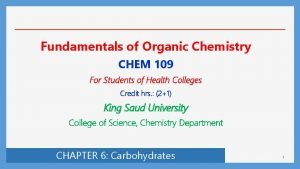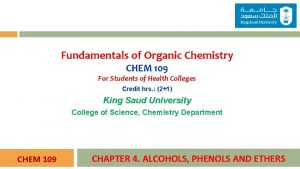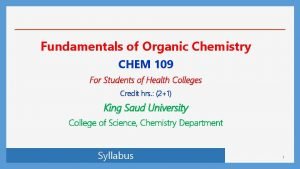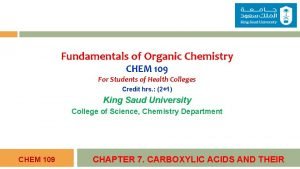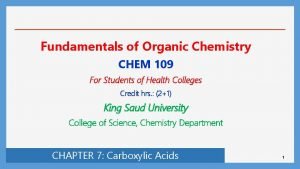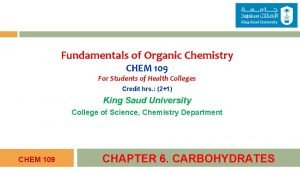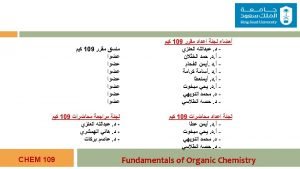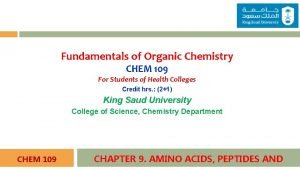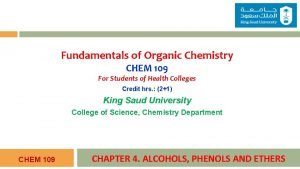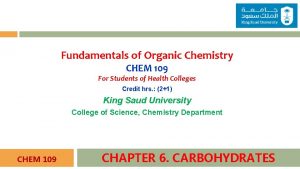Fundamentals of Organic Chemistry CHEM 109 For Students




























- Slides: 28

Fundamentals of Organic Chemistry CHEM 109 For Students of Health Colleges Credit hrs. : (2+1) King Saud University College of Science, Chemistry Department CHEM 109 CHAPTER 5. ALDEHYDES & KETONES

Learning Objectives 2 At the end of this chapter, students will able to: Know the structural differences between aldehydes and ketones Know how to draw aldehydes and ketones know the common and IUPAC nomenclature of aldehydes and ketones Know the physical properties of aldehydes and ketones Know how to synthesize an aldehyde or a ketone. Know the different nucleophilic addition reactions at the carbonyl carbon.

ommon Classes of Carbonyl Compounds 3 Class General Formula Class Ketones Aldehydes Carboxylic acids Acid Chlorides Esters Amides General Formula

The Carbonyl Group 4 o o o The carbon–oxygen double bond consists of a sigma bond a pi bond. The carbon atom is sp 2 -hybridized. The three atoms attached to the carbonyl carbon lie in a plane with bond angles of 120°. The pi bond is formed by overlap of a p orbital on carbon with an oxygen p orbital. There also two unshared electron pairs on the oxygen atom. The C=O bond distance is 1. 24 A, shorter than the C-O distance in alcohols and ethers (1. 43 A).

The Carbonyl Group 5 o Oxygen is much more electronegative than carbon. Therefore, the electrons in the C=O bond are attracted to the oxygen, producing a highly polarized bond. o As a consequence of this polarization, most carbonyl reactions involve nucleophilic attack at the carbonyl carbon, often accompanied by addition of a proton to the oxygen (electron rich).

tructure of Aldehydes and Ketones 6 o Aldehydes and ketones are characterized by the presence of the carbonyl group. o Aldehydes have at least one hydrogen atom attached to the carbonyl carbon atom. The remaining group may be another hydrogen atom or any aliphatic or aromatic organic group. o The -CH=O group characteristic of aldehydes is often called a formyl group. In ketones, the carbonyl carbon atom is connected to two other carbon atoms.

7 IUPAC System Nomenclature of Aldehyde o Aliphatic aldehydes are named by dropping the suffix -e from the name of the hydrocarbon that has the same carbon skeleton as the aldehyde and replacing it with the suffix -al. Alkane - e+ al = Alkanal o Substituted aldehydes, we number the chain starting with the aldehyde carbon. § -CH=O group is assigned the number 1 position. § Aldehyde group has priority over a double bond or hydroxyl group.

8 IUPAC System Nomenclature of Aldehyde o Cyclic aldehydes, the suffix –carbaldehyde is used. o Aromatic aldehydes are usually designated as derivatives of the simplest aromatic aldehyde, benzaldehyde.

9 Nomenclature of Aldehyde Common Names o Common names of ketones are formed by adding the word ketone to the names of the alkyl or aryl groups attached to the carbonyl carbon. Alkyl ketone. o In still other cases, traditional names are used. Ethyl methyl ketone Cyclopentyl ethyl ketone

Nomenclature of Ketones IUPAC Names 10 o In the IUPAC system, the ending for ketones is -one. o The chain is numbered so that the carbonyl carbon has the lowest possible number. o For cyclic ketones, numbering always starts from the C=O group. o The prefix "oxo" is used when the ketone is not the principal functional group. 1 -phenylethanone Diphenylmethanone Dicyclopropylmethanone

NOTES 11 Nomenclature of Aldehydes and Ketones o In common names carbon atoms near the carbonyl group are often designated by Greek letters. o The atom adjacent to the function is alpha (α), the next removed is beta (β) and so on. Since ketones have two sets of neighboring atoms, one set is labeled α, β etc. , and the other α', β' etc. o The functional group priority order in nomenclature system is as following: Acid and derivatives >aldehyde> ketone> alcoho > amine > alkene > alkyne >

ysical Properties of Aldehydes and Ketones 12 Boiling Points Ø Carbonyl compounds boil at higher temperatures than hydrocarbons, but at lower temperatures than alcohols of comparable molecular weight. Ø This is due to the intermolecular forces of attraction, called dipole-dipole interactions, which is stronger than van der Waals attractions but not as strong as hydrogen bonds.

ysical Properties of Aldehydes and Ketones 13 Solubili ty o Carbonyl compounds as aldehydes and ketones have a C=O bond, but no O-H bond, cannot form hydrogen bonds with themselves. o The polarity of the carbonyl group also affects the solubility properties of aldehydes and ketones. o Carbonyl compounds with low molecular weights are soluble in water as they can form hydrogen bonds with O-H or N-H compounds.

14 Preparation of Aldehydes and Ketones 1) Oxidation of Primary and Secondary Alcohols 2) Hydration of Alkynes Hydration of terminal alkynes EXCEPT acetylene yields ketones (catalyzed by acid and mercuric). 3) Ozonolysis of Alkenes

15 Preparation of Aldehydes and Ketones 4) Friedel-Crafts Acylation Preparing ketones that contain an aromatic ring.

A) Reduction 16 Compounds of Carbonyl Reactions of Aldehydes and Ketone o Aldehydes and ketones are easily reduced to primary and secondary alcohols, respectively. o The most common metal hydrides used to reduce carbonyl compounds are lithium aluminum hydride (Li. Al. H 4) and sodium borohydride (Na. BH 4). o Example:

B) Oxidation 17 Compounds of Carbonyl Reactions of Aldehydes and Ketone o Oxidation of aldehydes gives a carboxylic acid with the same number of carbon atoms. o Because the reaction occurs easily, many oxidizing agents, such as KMn. O 4, Cr. O 3, Ag 2 O and peracids will work. o Example:

C) Nucleophilic 18 Reactions Addition Reactions of Aldehydes and Ketone o Nucleophiles attack the carbon atom of a carbon-oxygen double bond because that carbon has a partial positive charge. o The overall reaction involves addition of a nucleophile and a proton across the pi bond of the carbonyl group (when carried out in alcohol or water).

Reactions of Aldehydes and Ketone C) Nucleophilic Addition 19 Reactions 1) Addition of Grignard Reagents: Formation of Alcohols o Grignard reagents act as carbon nucleophiles toward carbonyl o compounds. The reaction of a Grignard reagent with a carbonyl compound provides a useful route to alcohols. o The type of carbonyl compound chosen determines the class of alcohol

Reactions of Aldehydes and Ketone C) Nucleophilic Addition 20 Reactions 1) Addition of Grignard Reagents: Formation of o Formaldehyde gives primary alcohols. Alcohols o Other aldehydes give secondary alcohols o Ketones give tertiary alcohols.

Reactions of Aldehydes and Ketone C) Nucleophilic Addition 21 Reactions 2) Addition of Hydrogen Cyanide: Formation of o Hydrogen cyanide adds to the carbonyl group of aldehydes and ketones Cyanohydrins to form cyanohydrins, compounds with a hydroxyl and a cyano group attached to the same carbon. o Example

Reactions of Aldehydes and Ketone C) Nucleophilic Addition 22 Reactions 3) Addition of Alcohols: Formation of Hemiacetals o Alcohols add to the C=O bond, the OR group becoming attached to the carbon and the and Acetals proton becoming attached to the oxygen. o Aldehydes and ketones react with alcohols to form, first, hemiacetals and then, if excess alcohol is present, acetals. o Hemiacetals; it contains both alcohol and ether functional groups on the same carbon atom. o Acetals have two ether functions at the same carbon atom.

Reactions of Aldehydes and Ketone C) Nucleophilic Addition 23 Reactions 3) Addition of Alcohols: Formation of Hemiacetals and Acetals o The reverse of acetal formation, called acetal hydrolysis. o Acetal can be hydrolyzed to its aldehyde or ketone and alcohol components by treatment with excess water in the presence of an acid catalyst.

Reactions of Aldehydes and Ketone C) Nucleophilic Addition 24 Reactions 4) Addition of Ammonia and Ammonia The addition of nitrogen nucleophile, such as ammonia(NH 3) and Derivatives substituted ammonia (NH 2 -Y).

Uses of Aldehydes and ketones 25 Aldehydes and ketones find application in different sectors such as pharmaceutical, food, fragrance, cosmetics because of their chemical properties. q Formaldehyde is found in the gaseous form. Ø Formaldehyde with 40% solution in water forms formalin, helps in the preservation of biological specimens. Ø It is essential during industrial processes manufacture of polymeric products. Ø It acts as germicide, insecticide, and fungicides. Ø It helps in the testing of drugs. It is also used in photography. Ø It forms with ammonia a tricyclic condensation product called methenamine (hexamethylenetetramine). Methenamine is used for the treatment of urinary tract infection: it decomposes at an acid p. H to formaldehyde and ammonia, and the formed formaldehyde is bactericidal.

Uses of Aldehydes and ketones 26 The applications of aldehydes and ketones are used in different sectors such as pharmaceutical, food, fragrance, cosmetics industry. q Acetaldehyde Ø It is used for the production of acetic acid and pyridine derivatives. Ø Its derivative, paraldehyde was once used as sedative and hypnotic drug. q q q Benzaldehyde Ø It is an essential component for the production of perfumes, cosmetic products, and dyes. Ø is added to incorporate almond flavor into various food products. Ø It also acts as a bee repellant. Anisaldehyde, vanillin or cinnamaldehyde are mainly used in cosmetics, but also in drug formulation. Glutaraldehyde is used to disinfect medical and dental equipment.

Uses of Aldehydes and ketones 27 Therapeutic applications of aldehydes and ketones Compound Name in the Pharmacopoeia Application Aldehydes and analogues Formaldehyde Formaldehydi solution (35 per centum) antiseptic Paraldehyde Paraldehydum Chloral hydrate Chlorali hydras Methenamine Methenaminum sedative and hypnotic antiseptic

Uses of Aldehydes and ketones 28 Ketone behaves as an excellent solvent for certain types of plastics and synthetic fibers. q Acetone Ø It act as a paint thinner and a nail paint remover. Ø It is also used for medicinal purposes such as chemical peeling procedure as well as acne treatments. q Butanone Ø It is one of the common solvents. Ø It is used in textile production, varnishes production, paint remover production, paraffin wax production, plastic production, etc. q q Cyclohexanone is an important component in nylon production. Acetophenone is responsible for fragrances such as cherry, jasmine, honeysuckle, almond, strawberry, etc.
 Chem 109
Chem 109 Ib organic chemistry
Ib organic chemistry Inorganic vs organic chemistry
Inorganic vs organic chemistry Eth myth prop
Eth myth prop Qualitative organic analysis
Qualitative organic analysis Founder of organic chemistry
Founder of organic chemistry Canola oil
Canola oil Ester organic chemistry
Ester organic chemistry Nonene
Nonene Transition state energy diagram
Transition state energy diagram Ee organic chemistry
Ee organic chemistry Leveling effect organic chemistry
Leveling effect organic chemistry Pericyclic
Pericyclic Nomenclature of ethers
Nomenclature of ethers Klein organic chemistry 2nd edition
Klein organic chemistry 2nd edition Ario practice problems
Ario practice problems Ch3ch2ch2cooch(ch3)2 name
Ch3ch2ch2cooch(ch3)2 name Organic chemistry lab report format
Organic chemistry lab report format Organic chemistry conversion chart
Organic chemistry conversion chart Grade 10 organic chemistry
Grade 10 organic chemistry Cyclo organic chemistry
Cyclo organic chemistry Importance of organic compounds
Importance of organic compounds Organic chemistry wade
Organic chemistry wade Why is ceramic wool heated in cracking
Why is ceramic wool heated in cracking What is chemistry
What is chemistry Organic chemistry myanmar
Organic chemistry myanmar Hhcchh
Hhcchh M+1 peak
M+1 peak Hono organic chemistry
Hono organic chemistry
